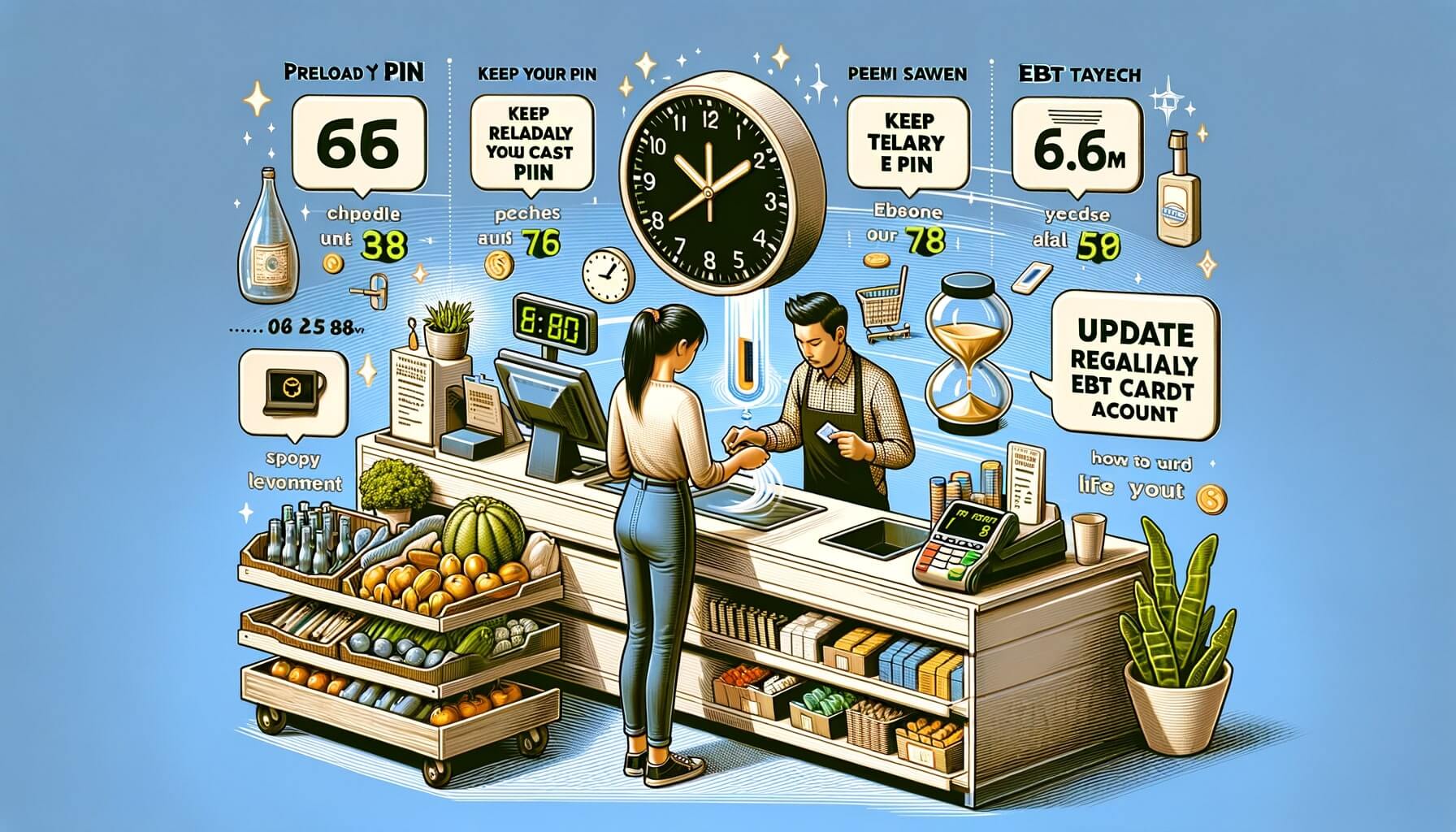
By Ethan Brooks February 9, 2025
In today’s fast-paced world, efficiency is key in every aspect of our lives, including the checkout process at grocery stores and supermarkets. For individuals relying on the Supplemental Nutrition Assistance Program (SNAP), commonly known as food stamps, Electronic Benefit Transfer (EBT) transactions are a vital part of their shopping experience.
However, the speed at which these transactions are processed can often be a source of frustration for both customers and cashiers. In this article, we will explore the importance of speeding up EBT transactions and provide a comprehensive guide on how to optimize the process for faster and smoother transactions.
The Basics of EBT Transactions: How Does It Work?
Before delving into the strategies for speeding up EBT transactions, it is essential to understand the basics of how this system works. EBT is an electronic system that allows recipients of SNAP benefits to access their funds through a plastic card, similar to a debit or credit card.
When a customer makes a purchase using their EBT card, the transaction is processed in real-time, deducting the amount from their available balance. The funds are then transferred to the retailer’s account, ensuring a seamless and secure transaction.
Common Challenges at the Checkout Counter: Identifying the Bottlenecks

Despite the convenience and efficiency of the EBT system, there are several common challenges that can slow down the checkout process. Identifying these bottlenecks is crucial in finding effective solutions to speed up EBT transactions. Some of the common challenges include:
1. Slow card processing: One of the primary causes of delays is the time it takes for the EBT card to be read and processed by the card reader. This can be due to outdated or malfunctioning equipment.
2. Incorrect entry of information: Cashiers may sometimes make errors when entering the transaction amount or other necessary information, leading to delays and potential rejections.
3. Connectivity issues: In some cases, poor internet connectivity or technical glitches can hinder the smooth processing of EBT transactions, causing delays and frustration for both customers and cashiers.
4. Lack of familiarity with the system: Cashiers who are not well-trained or experienced in handling EBT transactions may take longer to process them, leading to delays and potential errors.
Optimizing EBT Transactions: Tips for Faster Processing

Now that we have identified the common challenges, let’s explore some effective strategies to optimize EBT transactions for faster processing. By implementing these tips, both customers and cashiers can experience a smoother and more efficient checkout process.
1. Ensure up-to-date equipment: Investing in modern and reliable card readers and point-of-sale (POS) systems is crucial for speeding up EBT transactions. Outdated equipment can significantly slow down the processing time, leading to frustration for both customers and cashiers.
2. Train cashiers effectively: Providing comprehensive training to cashiers on how to handle EBT transactions is essential. This includes familiarizing them with the system, teaching them how to enter information accurately, and troubleshooting common issues that may arise during the process.
3. Encourage self-service: Educating customers on how to use self-checkout kiosks or EBT-enabled payment terminals can significantly speed up the transaction process. By empowering customers to handle their transactions independently, cashiers can focus on assisting other customers, leading to shorter wait times.
4. Implement barcode scanning: Utilizing barcode scanning technology can expedite the checkout process by automatically entering the product information and price into the system. This eliminates the need for manual entry, reducing the chances of errors and saving time.
5. Optimize internet connectivity: Ensuring a stable and fast internet connection is crucial for seamless EBT transactions. Retailers should invest in reliable internet service providers and consider backup options in case of connectivity issues.
6. Streamline the transaction flow: Organizing the checkout counter in a way that minimizes unnecessary movements and maximizes efficiency can significantly speed up EBT transactions. Cashiers should have easy access to the necessary equipment and be able to navigate the system quickly.
7. Utilize quick keys: Many modern POS systems offer the option to assign quick keys for frequently purchased items. Cashiers can use these keys to expedite the entry of common products, reducing the time spent on manual entry.
8. Implement contactless payment options: With the rise of contactless payment methods, such as mobile wallets and NFC-enabled cards, offering these options for EBT transactions can significantly speed up the process. Customers can simply tap their EBT card or mobile device on the reader, eliminating the need for swiping or inserting the card.
9. Use transaction batching: Batching multiple EBT transactions together can save time by reducing the number of individual authorizations required. This is particularly useful during peak hours when there is a high volume of EBT transactions.
10. Regularly update software: Keeping the EBT software up to date is crucial for optimal performance. Regular updates often include bug fixes, security enhancements, and improved processing speed, ensuring a smooth and efficient transaction experience.
Choosing the Right EBT Equipment: Enhancing Efficiency at the Counter

Selecting the right EBT equipment is essential for enhancing efficiency at the checkout counter. Retailers should consider several factors when choosing their EBT equipment to ensure faster processing and a seamless customer experience.
1. Compatibility with EBT system: It is crucial to choose EBT equipment that is compatible with the specific EBT system used by the state or region. This ensures smooth integration and reduces the chances of compatibility issues that can slow down transactions.
2. Speed and reliability: Opting for high-speed and reliable card readers and POS systems is essential for faster EBT transactions. Equipment with advanced processing capabilities can significantly reduce the time it takes to process each transaction.
3. User-friendly interface: The EBT equipment should have a user-friendly interface that is easy for cashiers to navigate. Intuitive design and clear instructions can minimize errors and speed up the transaction process.
4. Durability and maintenance: Investing in durable and low-maintenance EBT equipment is crucial for long-term efficiency. Equipment that requires frequent repairs or replacement can lead to downtime and delays in processing transactions.
5. Scalability: Retailers should consider the scalability of their EBT equipment, especially if they anticipate an increase in the volume of EBT transactions. Choosing equipment that can handle higher transaction volumes without compromising speed and efficiency is essential for future-proofing the checkout process.
Streamlining the Checkout Process: Best Practices for Cashiers

Cashiers play a vital role in ensuring a smooth and efficient checkout process for EBT transactions. By following best practices, cashiers can streamline the process and minimize delays. Here are some tips for cashiers to optimize the checkout process:
1. Greet customers and explain the process: Cashiers should greet customers with a friendly demeanor and explain the EBT transaction process, especially if the customer is unfamiliar with it. This helps set expectations and reduces confusion during the transaction.
2. Verify customer eligibility: Cashiers should verify the customer’s eligibility for SNAP benefits before starting the transaction. This can be done by checking the expiration date on the EBT card or asking for identification if required.
3. Double-check entered information: Accuracy is crucial when entering transaction amounts and other necessary information. Cashiers should double-check the entered information to minimize errors and potential delays.
4. Communicate effectively: Clear and concise communication between cashiers and customers is essential for a smooth transaction process. Cashiers should explain any additional steps or requirements clearly to avoid confusion or misunderstandings.
5. Be prepared for common issues: Cashiers should familiarize themselves with common issues that may arise during EBT transactions, such as declined cards or connectivity problems. Being prepared to handle these issues efficiently can minimize delays and frustration.
6. Maintain a steady pace: Cashiers should strive to maintain a steady pace during EBT transactions, ensuring efficient processing without rushing the customer. Finding the right balance between speed and customer service is crucial for a positive experience.
7. Offer assistance when needed: Some customers may require additional assistance or have questions during the transaction. Cashiers should be attentive and offer help when needed, ensuring a smooth and efficient process for all customers.
8. Stay updated on EBT policies: EBT policies and regulations may change over time. Cashiers should stay updated on any policy changes to ensure compliance and avoid potential delays or issues during transactions.
9. Seek feedback and improvement opportunities: Cashiers should actively seek feedback from both customers and supervisors to identify areas for improvement. This can help streamline the checkout process and enhance efficiency in handling EBT transactions.
10. Maintain a positive attitude: A positive and friendly attitude can go a long way in creating a pleasant checkout experience for customers. Cashiers should strive to maintain a positive demeanor, even during busy or challenging times, to ensure customer satisfaction.
Utilizing Technology: Tools and Software for Faster EBT Transactions
Technology plays a crucial role in speeding up EBT transactions and enhancing efficiency at the checkout counter. Retailers can leverage various tools and software to optimize the process and provide a seamless experience for both customers and cashiers. Here are some technology solutions that can expedite EBT transactions:
1. Modern card readers: Investing in modern card readers with advanced processing capabilities can significantly reduce the time it takes to process EBT transactions. These card readers often have faster transaction speeds and improved connectivity, minimizing delays.
2. Point-of-sale (POS) systems: Upgrading to a modern POS system can streamline the entire checkout process, including EBT transactions. These systems often come with features such as barcode scanning, quick keys, and intuitive interfaces, enhancing efficiency and reducing errors.
3. Mobile payment apps: Some EBT programs offer mobile payment apps that allow customers to manage their benefits and make purchases using their smartphones. These apps can expedite the transaction process by eliminating the need for physical cards and reducing manual entry.
4. Cloud-based EBT software: Cloud-based EBT software offers several advantages, including faster processing speeds and real-time updates. This type of software allows for seamless integration with other systems, such as inventory management and reporting tools, further enhancing efficiency.
5. Self-checkout kiosks: Implementing self-checkout kiosks that support EBT transactions can significantly speed up the checkout process. Customers can handle their transactions independently, reducing the workload on cashiers and minimizing wait times.
6. Mobile wallet integration: Integrating EBT functionality into popular mobile wallet apps, such as Apple Pay or Google Pay, can expedite the transaction process. Customers can simply tap their mobile devices on the reader, eliminating the need for physical cards and reducing manual entry.
7. Real-time inventory management: Utilizing real-time inventory management systems can enhance efficiency during EBT transactions. Cashiers can quickly check product availability and make necessary adjustments, reducing the time spent on manual inventory tracking.
8. Customer-facing displays: Implementing customer-facing displays at the checkout counter can enhance transparency and speed up EBT transactions. Customers can verify the transaction amount and other details, reducing the need for clarification and potential errors.
9. Automated reporting and reconciliation: Automating the reporting and reconciliation process can save time and reduce the chances of errors during EBT transactions. Retailers can leverage software solutions that generate detailed reports and reconcile transactions automatically, streamlining the administrative tasks associated with EBT.
10. Integration with loyalty programs: Integrating EBT transactions with existing loyalty programs can enhance efficiency and provide additional benefits for customers. Cashiers can quickly apply loyalty rewards or discounts, reducing the time spent on manual calculations.
Educating Customers: Promoting Self-Service and Efficiency
Educating customers on how to use the EBT system efficiently is crucial for speeding up transactions and promoting self-service. By providing clear instructions and resources, retailers can empower customers to handle their transactions independently, reducing the workload on cashiers and minimizing wait times. Here are some strategies for educating customers:
1. Clear signage and instructions: Displaying clear signage and instructions at the checkout counter can guide customers on how to use their EBT cards and navigate the transaction process. This includes information on where to swipe or insert the card, how to enter the PIN, and any additional steps required.
2. Online tutorials and videos: Creating online tutorials or videos that explain the EBT transaction process can be a valuable resource for customers. Retailers can share these resources on their website or social media platforms, allowing customers to access them at their convenience.
3. In-store demonstrations: Hosting in-store demonstrations or workshops can help customers become familiar with the EBT system and gain confidence in handling their transactions. These demonstrations can be led by knowledgeable staff members or external experts.
4. Printed guides and brochures: Providing printed guides or brochures that outline the EBT transaction process can serve as a handy reference for customers. These materials can be made available at the checkout counter or customer service desk.
5. Customer support hotline: Establishing a dedicated customer support hotline for EBT-related inquiries can provide customers with immediate assistance when needed. This hotline can be staffed by knowledgeable personnel who can guide customers through any issues or questions they may have.
6. Interactive online resources: Creating interactive online resources, such as FAQs or chatbots, can provide customers with instant answers to their EBT-related queries. These resources can be accessible through the retailer’s website or mobile app.
7. Collaborate with community organizations: Partnering with local community organizations that specialize in SNAP benefits and EBT transactions can be a valuable resource for customers. These organizations can provide workshops, counseling, and personalized assistance to customers, ensuring they have the necessary knowledge to navigate the EBT system efficiently.
8. Feedback and suggestion boxes: Placing feedback and suggestion boxes at the checkout counter allows customers to provide input on their EBT transaction experience. Retailers can use this feedback to identify areas for improvement and tailor their educational efforts accordingly.
9. Social media engagement: Leveraging social media platforms to engage with customers and address their EBT-related questions or concerns can be an effective way to educate a wider audience. Retailers can create dedicated social media accounts or use existing accounts to provide timely and helpful information.
10. Continuous communication: Regularly communicating with customers about any updates or changes to the EBT system is crucial for ensuring a smooth transaction process. Retailers can utilize various channels, such as email newsletters, SMS alerts, or in-store announcements, to keep customers informed and educated.
Overcoming Potential Issues: Troubleshooting EBT Transaction Delays
Despite implementing the strategies mentioned above, there may still be instances where EBT transaction delays occur. Here are some potential issues and troubleshooting steps:
1. Network Connectivity Issues: If there are network connectivity issues, cashiers should check the internet connection and ensure it is stable. Restarting the router or contacting the internet service provider may be necessary.
2. Card Balance Insufficient: If a customer’s EBT card balance is insufficient to cover the purchase, cashiers should inform the customer and offer alternative payment options. This can help avoid delays caused by declined transactions.
3. Card Activation Problems: If a customer’s EBT card is not activated or has expired, cashiers should inform the customer and provide guidance on how to resolve the issue. This may involve contacting the appropriate EBT agency or issuing a new card.
4. System Outages: In the event of system outages or technical difficulties, cashiers should follow the established protocols provided by the EBT system provider. This may involve using manual voucher systems or alternative payment methods.
5. Customer Verification Issues: If a customer’s identity or eligibility cannot be verified, cashiers should follow the established procedures for resolving such issues. This may involve contacting the EBT system provider or requesting additional documentation from the customer.
FAQs
Q1. Can EBT transactions be faster than traditional payment methods?
Yes, EBT transactions can be faster than traditional payment methods, especially when retailers have optimized their systems and trained their cashiers to efficiently process EBT transactions.
Q2. Can customers split payments between EBT and other payment methods?
Yes, customers can split payments between their EBT card and other payment methods, such as cash, credit, or debit cards. However, this may require additional steps and verification at the checkout counter, potentially leading to longer transaction times.
Q3. Are there any restrictions on what items can be purchased with EBT benefits?
Yes, there are restrictions on what items can be purchased with EBT benefits. Generally, EBT benefits can only be used to purchase food items that are intended for human consumption. Items such as alcohol, tobacco, pet food, and hot prepared foods are typically not eligible for purchase with EBT benefits.
Q4. Can EBT transactions be processed offline?
No, EBT transactions require real-time communication between the EBT system and the retailer’s POS system. Therefore, a stable internet connection is necessary for processing EBT transactions.
Q5. Can retailers charge additional fees for EBT transactions?
No, retailers are not allowed to charge additional fees for EBT transactions. Any fees associated with EBT transactions are typically covered by the EBT provider.
Conclusion
Speeding up EBT transactions at the checkout counter is crucial for both retailers and customers. By understanding the importance of efficiency, identifying common challenges, and implementing the strategies outlined in this article, retailers can optimize the EBT transaction process and provide a seamless checkout experience for their customers.
From ensuring reliable internet connectivity and upgrading EBT equipment to training cashiers effectively and utilizing technology, retailers have various tools at their disposal to enhance efficiency. Educating customers on how to use their EBT cards, promoting self-service options, and troubleshooting potential issues can further empower both retailers and customers.
By prioritizing speedy EBT transactions, retailers can improve customer satisfaction, reduce wait times, and increase overall operational efficiency. With a cohesive approach that combines technology, training, and customer education, retailers can create a checkout experience that is efficient, convenient, and empowering for all parties involved.